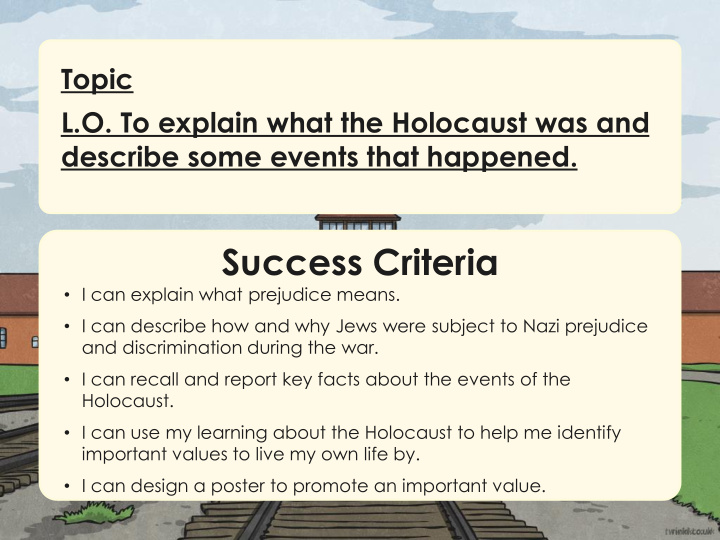



Topic L.O. To explain what the Holocaust was and describe some events that happened. Success Criteria • I can explain what prejudice means. • I can describe how and why Jews were subject to Nazi prejudice and discrimination during the war. • I can recall and report key facts about the events of the Holocaust. • I can use my learning about the Holocaust to help me identify important values to live my own life by. • I can design a poster to promote an important value.
The Bad Apple What if the apples were people? Both of these men lived during World War II. What do you think is similar and different about them? Do you think one man is better than the other? Which one? What are they like ‘on the inside’? Photo courtesy of unknown and Ge4rman Federal Archive (@Wikimedia Commons) - granted under creative commons licence - attribution
The Bad Apple This man is called Arnost Rosin. He was a Slovak Jew (from Slovakia) . During the war, Rosin was detained at a death camp in Auschwitz, Poland because he was Jewish and the Nazi regime believed he, and thousands of other Jews, deserved to die – just because they were Jewish. Luckily, Rosin escaped from Auschwitz on 27th May, 1944. This man is called Joseph Goebbels. He was a close friend of Adolf Hitler and member of the Nazi party. Goebbels had a strong hatred for the Jewish people and believed they should be exterminated. He was in charge of propaganda during the war that aimed to promote and justify this extreme form of prejudice.
The Bad Apple How do you feel reading about Rosin and Goebbels? How does the comparison between Rosin and Goebbels compare with the comparison of the apples?
The Holocaust The Holocaust describes the killing of over six-million Jews before and during World War II. These killings were organised by the German Nazi party and were directed by the party leader, Adolf Hitler. Hitler blamed the Jews for Germany losing the First World War and for the financial problems in Germany during the 1920s. In fact, Hitler sought to blame the Jews for many of his country’s problems. He made the Jews a scapegoat and sought to promote a widespread public hatred of The Jews pictured here them. are being made to walk This prejudice against Jews is called with antisemitic signs antisemitism. during a boycott of Jewish shops. scapegoat – person(s) blamed for the wrongdoing or mistakes of others The year is 1933.
The Holocaust The discrimination against Jewish people in Germany had begun before the war. Jews were made to sit on designated seats on buses and trains, people were stopped from buying goods at Jewish shops and even school children were openly bullied and humiliated by other pupils and their teachers. Hitler’s antisemitic propaganda campaign utilised radio, newspapers and leaflets to incite hatred towards the Jews and promote the supposed superiority of the pure German race. During the war, the persecution of Jews became much worse. Millions of Jews in Germany and other This picture shows Nazi soldiers forcing occupied countries were Jews out of hiding in Warsaw, Poland. subjected to horrific abuse, exploitation and death.
The Holocaust The Jewish people lived in constant fear of being captured. Those who tried to fight back were shot or publically humiliated and tortured by the Nazi soldiers. Jews found in hiding were rounded up and sent on cramped buses and trains to meet an unknown fate. Families were often separated. Many Jews were sent to concentration camps where they were forced to work like slaves. Many died through infection, starvation or exhaustion. Others were sent to death camps where they were killed in gas chambers. This form of mass killing is called genocide. Death camp at Auschwitz, Poland
The Holocaust At the end of the war, mass graves were revealed containing the bodies of thousands of people, who had been mercilessly executed. The Jews and prisoners of war living in concentration camps were liberated and revealed the horrific truth about their treatment. Most were starving and badly beaten. It was not just Jewish people that were victims. Hitler also targeted people from certain countries like Poland and the Soviet Union and minority groups, such as, homosexuals and disabled people. The atrocities committed during the Holocaust are still as shocking today as they were during the war. You can read some Holocaust survivor stories here.
The Holocaust Anne Frank Anne Frank was a Jewish girl, who was born in Germany on 12th June 1929. During the war, Anne’s family were forced to go into hiding in Amsterdam and during this time, Anne kept a diary about her experiences. Eventually, the family were captured and sent to a concentration camp. Anne’s father, Otto, was the only member of the family to survive. He decided to share his daughter’s diary, which was first published in 1947. You can watch an interview with Anne’s father here.
Lessons to Live By Choose one of the values you have identified as important. Design your own poster to promote this value to other children in school. You could include: a slogan or rhyme; • pictures; • statistics; • quotes from people; • You should also consider: colour; • font; • the shape and size of words and images. •
Recommend
More recommend